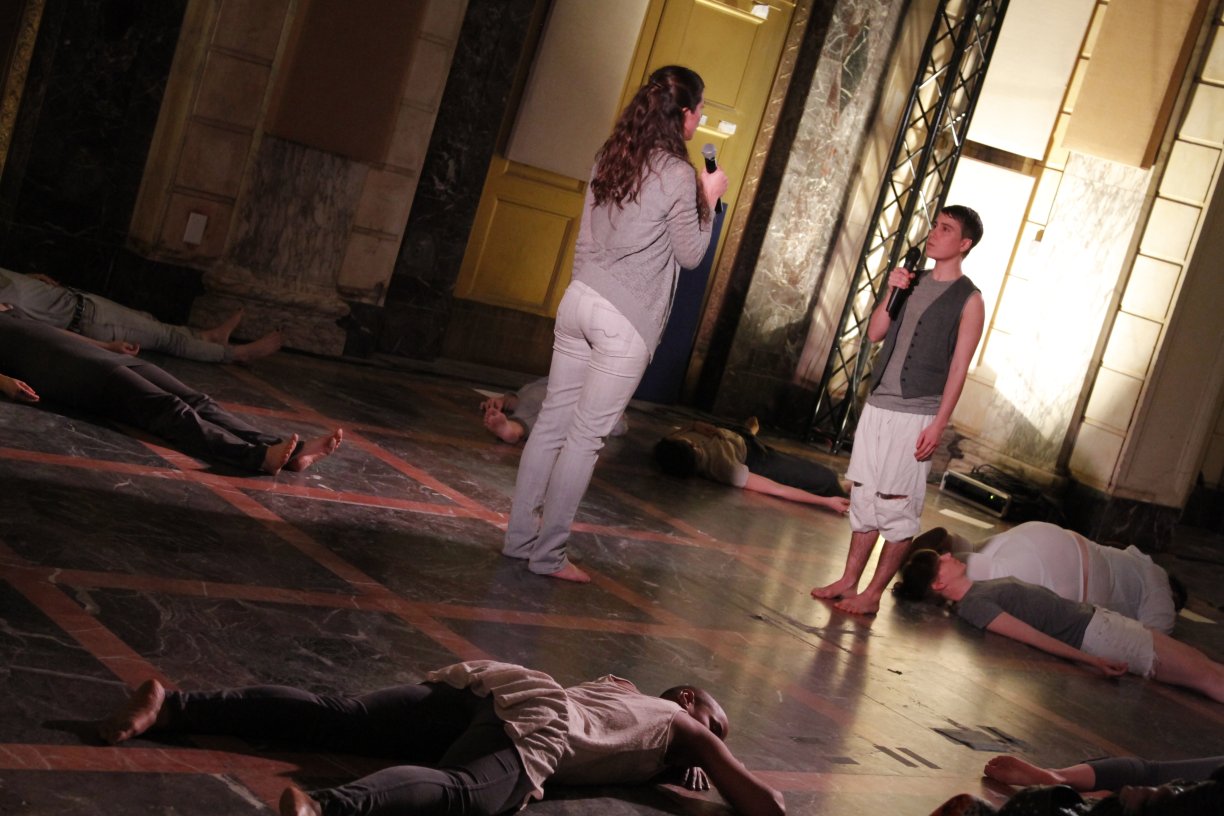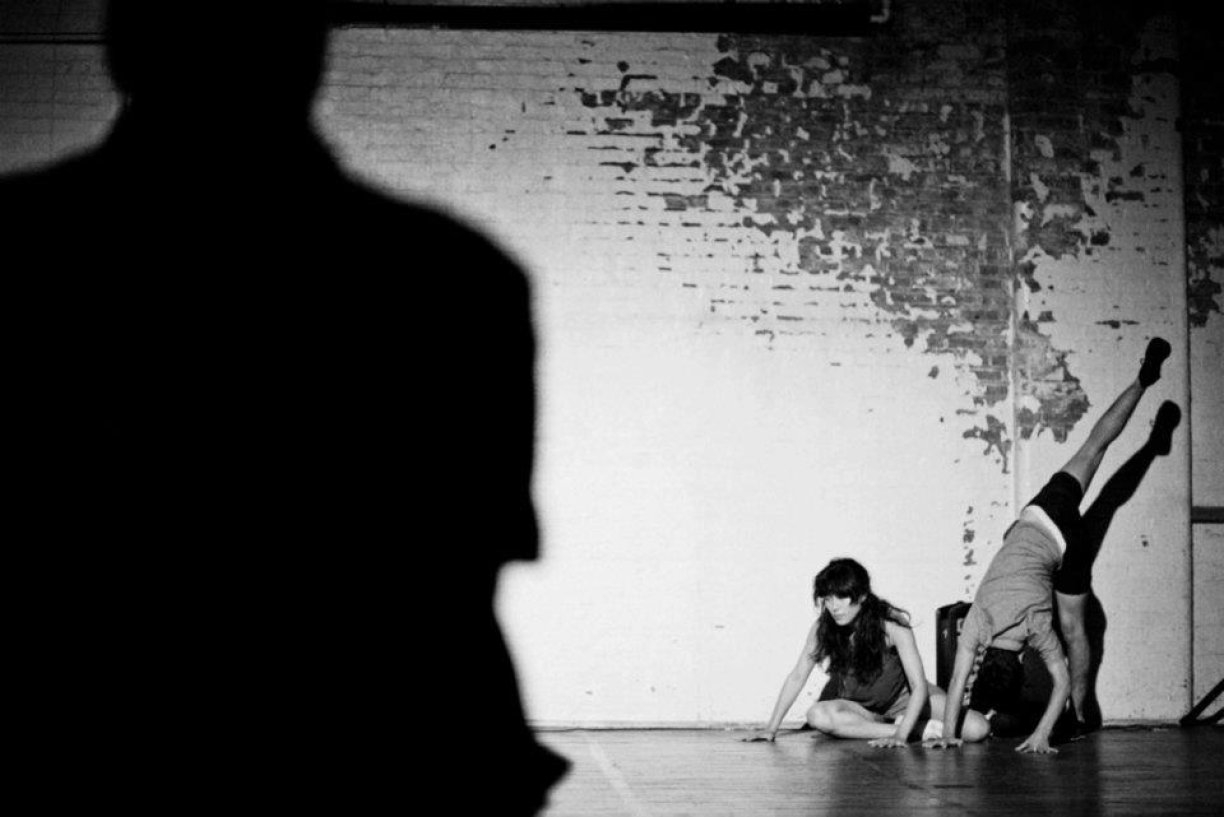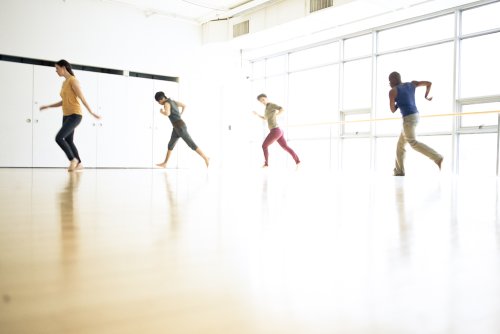devynn emory sat down with me to reflect on their performance evening, baby, presented as part of their residency at ISSUE in April 2013. For emory, performance takes many forms, from tightly choreographed dance, to group ritual, to music videos, to vocal composition and poetic monologue. The early influence of feminist genderqueer art collective, LTTR, and their publication “Practice More Failure,” as well as the theoretical writing of José Muñoz, and Yoko Ono’s conceptual instructions in Grapefruit come together to inform emory’s experimental approach to the making of baby.
Over the course of our conversation, I came to learn from emory that the space of dance is as much conceptual as it is physical, and this space is also as much about the co-creation of identity as it is about understanding its polymorphic manifestations. In emory’s program notes, they say, “i want to create an experience that is just for us, shifting the experience from the position of the object to the position of the subject.” The “us” is the gnc (gender non-conformist) and poc (people of color) communities of artists and activists that are part of emory’s worlds, traversing the country from New York, to Philadelphia to Los Angeles. In Part 1 of the evening, entitled baby, members of these communities participated in a group performance composed of experiential movement scores and letters between Oscar Wilde and his lover. For some, this was the first time they had performed outside of their everyday experiences where their difference is commonly objectified. baby placed their bodies in the vulnerable space of visibility, inviting the audience to see them as subjects within a larger context of difference.
In Part 2 of the evening, grapefruit baby, emory and collaborator Margot Bassett performed a vocal duet composed from the song, “Hood” by Perfume Genius. emory started working with the song in the Summer of 2012 as part of the Boatel project on the Rockaways. With an i-phone and flamboyant props strewn around the boat-cum-hotel-cum-studio, emory and filmmaker-editor, Aden Hakimi recorded a cover of the music video of “Hood.” Their trans-masculine presences offered a new perspective on the song and the performance of gender. emory abstracted the song’s meaning further in their Oulipian acapella duet with Bassett. In their repetition of “baby,” the two inflected a range of associations and meanings attached to the word. The duet’s technical precision removed the song from sentimentality, deconstructing the very idea of “baby” as the object of desire. Underlying the deconstructed song is the question of power dynamics within relationships and how that power dynamic can be undone.
The final part of the evening, one brown and one creme, is a text written by emory and read by Meghan Milam. The text was inspired by the lavish marble walls of ISSUE's space, which evoked a series of surreal images for emory. These images formed to create a visual narrative of an imaginary performance involving falling glass, people riding into the space on horses, sweating yellow paint, long braided hair, and figures in beards and dresses dancing. As Milam read, audience members could visualize themselves within these fantastical scenarios, which offered yet another way to experience otherness. In the life of the mind anything is possible, concepts which can’t be realized in real time open up to new ways of seeing the performance space and our desires for what can happen within it. This final piece of emory’s performance triptych took the sphere of listening into a radical direction, evocative of Dada, pataphysics, Fluxus and Skinner Releasing visualizations.
The following conversation is an excerpt from our interview about emory’s reflections on this evening; their experience of working with untrained performers, with their voice, with identity as subject matter, and the multiple permutations of dance composition throughout emory’s performances.
devynn emory: Often when people who see my work want to discuss it with me, their perceptions are overshadowed because they are preoccupied with me identifying as trans. I aim to expand this dialogue, as I'm not interested in making work "about" my identity. In fact, my work is never "about" a topic...that's just not how I approach art making. I understand my body as one of many constructions and further- our construction of body and self influences everything. It is part of everyday decision-making and part of artistic choices. Choreography houses many sets of decisions.
Marissa Perel: You want to be able to navigate the world the way you are and be an artist.
de: Yes, I prefer to be an artist in the world. I happen to be trans, my body happens to be the way it is, I happen to be a mixed race person, I happen to be a queer person, these are some of the many histories that my body holds. To me its already inherent in my work because of how my body appears, but maybe it is not always so overt. I think that’s why where we are right now is interesting because the dance world is making more room for such bodies, but at the same time I don’t feel that I should have to make work about it.
With this contradiction in mind, I decided to try out making a performance “about” this stuff, doing something uncharacteristic of my practice. I was highly influenced by LTTR, and the diversity of queer bodies on stage, non-performer bodies, performer bodies, and untrained bodies. The participants and audience members came from a queer fine arts world and a queer activist world, as these are a few of the communities that I belong to outside of dance. I was interested to see how writing about my work in relationship to queerness brought particular queer audiences, and to find that my dance audience wasn't present. It was the first time that I wrote publicly about my work before showing it and the outcome was fascinating.
MP: It seems like writing played a major part in the parts of baby. Each of the pieces drew heavily from a written component, a score, a composition, a story...
de: It’s true, though I wouldn’t call myself a writer. I'm curious about a recent upswing of interest in many mediums getting involved in performance recently so chose to join in the conversation by starting to get involved with writing [laughs]. My partner mentioned Yoko Ono to me, and I thought, “Of course!” There is a chapter in her book Grapefruit, which is about how to make a painting based on a series of instructions. I've tried this approach w giving professional dancers a set of instructions to memorize and perform. This was a furthering of that investigation while asking questions of sustainability for the trained dancer. I was happy to work with "non" dancers for this score. Scoring allows me room for both realism in interpretation as well as an expansive outcome.
MP: So you’re making scores to imagine dance?
de: Yes, I think dance is so specific. I work it at, I edit it, i feed it, and hone it, and still it’s never what I thought it would be. The writing is a way to create exactly the image or picture of something that I want to show the audience. I can’t control the audience’s perceptions, but through the writing I can kind of curate the audience’s experience. It’s interesting to compare it to an exhibition of paintings where you really have no control over the audience’s reaction, where they came from, what kind of mood they’re in when they see the object, or how long they’ll take to look at it. In performance, you have a little more control over it because the audience is sitting there for a certain amount of time, and they are only watching your work.
I’m interested in describing a dance and having the outcome be something that I can’t control. It really goes against the grain of any of my comfort zones, and how I usually make work. But it’s ultimately like a collaboration because the performers bring their bodies and perceptions into it, and it manifests based on how they enact it.
MP: When you were seeing the score for Part 1 of baby being performed what was it like for you? Did it feel beyond your control as you had anticipated? Did it make you see your work in a different way?
de: It was so exciting and refreshing to work with a different group of people. I think the performers were very excited to be on a stage together, and that they felt connected to one another. There wasn’t a warm-up, people just came and were encountering each other for the first time on stage. It was very slow, filled with sensorial and exploratory bodies. The audience was excited to see people like themselves performing. It was reported to me that it still had all the flavors of my work, including ritual and an invitation into something personal and investigated yet unknown to the audience.
I do want to create a space for different bodies to be on stage. I don’t want that to be what the work is all about, but I want to continue to think about it. I was concerned about how it was perceived because I was facing a new audience with an entirely new way of working for me. I’m trying these things out for so many reasons. The main one being the body as the performer’s only tool for the work. I come from a very classically trained background, and that was my approach for a very long time. But for the first time I had an injury and then a surgery which altered my body’s ability to move, and it was in the midst of this residency. So I was investigating what to do when you have these issues if you have to keep working, if you’re at a residency, in a dance company, or you get an opportunity to make work. How can I sustainably keep my practice going?
MP: In having to answer this question for yourself, do you feel your aesthetics have to change in order to accommodate your physical changes?
de: I’ve been coming up against questions that I have yet to answer for myself about this type of work. It was the first time I made work that is not Dance with a capital D. I’m interested, as a choreographer, in the distinction between dance and performance. If an artist organizes a group of people to perform, is that a dance? How can I separate my work as a dancer from that? Where is the talk about all my years of dance training? Does that erase it, is that ok? Can I let go of that? I feel protective of that! I feel my body and its years of training-, i feel that held and i feel that release. In dancing for Tere O’Connor, he has a really specific viewpoint about choreography. His language points to choreography being really good at one thing. It doesn’t need narrative, it doesn’t need a set, it doesn’t need props. The body is the medium and that’s it. Is this 3 part work a performance or a dance? Is the vocal work a song or can it be perceived differently? I’m thinking of Jonathan Burrows and Matteo Fargion.
MP: What was your process in making the vocal work with Margot?
de: I took the song, “Hood” by Perfume Genius and broke it open. I turned it into fragments, and then I made those fragments into something new. This piece was continuing a lineage of formalism in my work, bringing it from the dancing body into the vocal chords. I find such satisfaction in mastering a very challenging vocal work, as if I’m doing fuete turns with many dancers too close. I thrive in the challenge. I also see the form of the duet as a relationship, in my work it is often a mirror, filled with intimacy and ritual. Our voices were marking the space, delineating our positions.
MP: How does dance inform your process in thinking about the text, one brown, one creme?
de: I was taking the closed, blank-faced container of the dancer’s persona and exploding it. The script I wrote was a score for a piece specific to the beautiful space of Issue Project Room. Meghan read aloud, creating an imaginary dance that was happening in the empty space, beginning with dancers entering stage left, transitioning into horses floating into the air to hang as chandeliers, to the audience sinking into the floor that had reversed into the ceiling. As I listened to her read the score, I realized that it wasn’t just an offering to the audience to broaden their perception, it was also a storytelling and a guided meditation into parts of my life that are deep within my artistic practices. I see glimpses of my background in radical protest, of my spiritual practices and my experience of being a gender fluid person. I am seeking to open up a space for new experiences and invite the audience into that space with me.
Marissa Perel is an artist, writer and independent curator based in Brooklyn. She runs Lobby TALKS at New York Live Arts and writes the column, “Gimme Shelter: Performance Now” on the Art21 blog. She was an editor of Critical Correspondence, the on-line performance journal of Movement Research, and is a contributor to BOMBlog and P-Club among others.
Photo: devynn emory, baby by Bradley Buehring.



